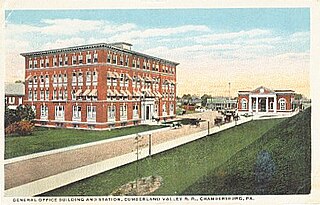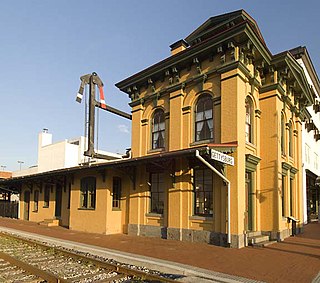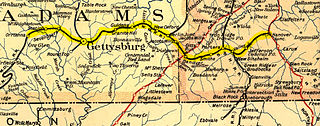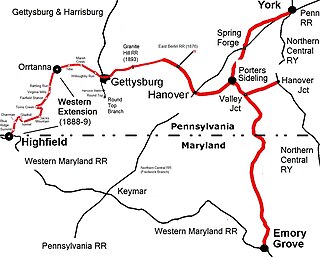
Cockeysville is a census-designated place (CDP) in Baltimore County, Maryland, United States. The population was 20,776 at the 2010 census.

The Baltimore and Ohio Railroad was the first common carrier railroad and the oldest railroad in the United States with its first section opening in 1830. Merchants from Baltimore, which had benefited to some extent from the construction of the National Road early in the century, wanted to do business with settlers crossing the Appalachian Mountains. The railroad faced competition from several existing and proposed enterprises, including the Albany-Schenectady Turnpike, built in 1797, the Erie Canal, which opened in 1825, and the Chesapeake and Ohio Canal. At first, the B&O was located entirely in the state of Maryland; its original line extending from the port of Baltimore west to Sandy Hook, Maryland, opened in 1834. There it connected with Harper's Ferry, first by boat, then by the Wager Bridge, across the Potomac River into Virginia, and also with the navigable Shenandoah River.

The Western Maryland Railway was an American Class I railroad (1852–1983) which operated in Maryland, West Virginia, and Pennsylvania. It was primarily a coal hauling and freight railroad, with a small passenger train operation.

The Northern Central Railway (NCRY) was a Class I Railroad connecting Baltimore, Maryland with Sunbury, Pennsylvania, along the Susquehanna River. Completed in 1858, the line came under the control of the Pennsylvania Railroad (PRR) in 1861, when the PRR acquired a controlling interest in the Northern Central's stock to compete with the rival Baltimore and Ohio Railroad (B&O).
The Department of the Susquehanna was a military department created by the United States War Department during the Gettysburg Campaign of the American Civil War. Its goal was to protect the state capital and the southern portions of the commonwealth of Pennsylvania, and to deny the Confederate army passage across the vital Susquehanna River.

The Hanover Subdivision is a railroad line owned and operated by CSX Transportation in the U.S. states of Maryland and Pennsylvania. The line runs from Baltimore, Maryland, west to Hagerstown, Maryland, along several former Western Maryland Railway (WM) lines. It meets the Baltimore Terminal Subdivision at its east end, and the Lurgan Subdivision heads both north and west from its west end.

The Cumberland Valley Railroad was an early railroad in Pennsylvania, United States, originally chartered in 1831 to connect with Pennsylvania's Main Line of Public Works. Freight and passenger service in the Cumberland Valley in south central Pennsylvania from near Harrisburg to Chambersburg began in 1837, with service later extended to Hagerstown, Maryland, and then extending into the Shenandoah Valley to Winchester, Virginia. It employed up to 1,800 workers.
During the American Civil War, Pennsylvania was the second largest state in the Union, and Harrisburg was the state's capital. Located at the intersection of important railroads, Harrisburg proved an important supply and logistics center for the dissemination and transportation of materiel for the Union Army. Tens of thousands of new recruits were mustered into service or drilled at a series of Harrisburg-area United States Army training camps, including the sprawling Camp Curtin. Confederate forces under Lieutenant General Richard S. Ewell threatened Harrisburg during the June 1863 Gettysburg Campaign, but were instead called by General Robert E. Lee to return to Gettysburg campaign. Pennsylvania Governor Andrew Curtin ordered local workers to erect a series of forts and earthworks to protect the city, which then had a population of 13,000 residents.

The Gettysburg Lincoln Railroad Station, also known as the "Gettysburg Train Station," "Lincoln Train Station" or "Western Maryland Railroad Station," is a historic train station with depot, platform, museum and offices on Carlisle Street in Gettysburg, Pennsylvania. Operable from 1858 to 1942, it contributes to the Gettysburg Battlefield Historic District and is most notable as President Abraham Lincoln's point of arrival on November 18, 1863 and departure, following delivery of the Gettysburg Address. The station served as both a hospital during the battle and hub for outgoing wounded soldiers and incoming resources and supplies following the end of the war. On 2015, following several years of delays, the station, which was originally owned by the Borough of Gettysburg but was bought by the Gettysburg Foundation, the non-profit partner to the National Park Service, was placed under the purview of the National Park Service.

Hanover Junction is a small unincorporated community, which is located in south-central York County, Pennsylvania, United States, near the borough of Seven Valleys. The junction serves as a rest stop on the York County Heritage Rail Trail.

The Gettysburg Railroad was a railway line in Pennsylvania that operated from 1858 to 1870 over the 17-mile (27 km) main line from the terminus in Gettysburg to the 1849 Hanover Junction. After becoming the Susquehanna, Gettysburg & Potomac Railway line in 1870, the tracks between Gettysburg and Hanover Junction became part of the Hanover Junction, Hanover and Gettysburg Railroad in 1874, the Baltimore and Harrisburg Railway in 1886, and the Western Maryland Railway in 1917.

The Hanover Junction, Hanover and Gettysburg Railroad was a railroad line in Pennsylvania in the 19th century. The 38 mile (61 km) main line ran from Orrtanna to Hanover Junction, where it connected with the Northern Central Railway. Connections along the main line were to the Gettysburg and Harrisburg Railroad, the Bachman Valley Railroad, and the Pennsylvania Railroad.

The Baltimore and Harrisburg Railway was a railroad that operated in Maryland and Pennsylvania in the 19th and early 20th centuries. The 59 miles (95 km) main line ran from Emory Grove, Maryland to Orrtanna, Pennsylvania, with a 6 miles (9.7 km) branch from Valley Junction, Pennsylvania to Hanover Junction, Pennsylvania; and later extensions to Highfield, Maryland and York, Pennsylvania.
The Susquehanna, Gettysburg and Potomac Railway (SG&P) was a railroad that operated in Pennsylvania in the 1870s. The 17 mile (27 km) main line ran from Gettysburg to Hanover.
The Baltimore and Hanover Railroad (B&H) was a railroad that operated in Maryland in the 19th century. The 20 mile (32 km) main line ran from Emory Grove, Maryland north to the Pennsylvania state line near Black Rock Junction, where it connected with the Bachman Valley Railroad.
The Bachman Valley Railroad (BV) was a railroad that operated in Pennsylvania and Maryland, United States, in the 19th century. The 13 mile (21 km) line ran from Valley Junction, Pennsylvania to Ebbvale, Maryland. The railroad was built to transport iron ore to local blast furnaces; it also carried some passengers. The railroad became part of the Western Maryland Railway in 1917.

The Gettysburg and Harrisburg Railway was a Pennsylvania line from near Carlisle southward to Gettysburg operated by a subsidiary of the Reading Company. The line also included the Round Top Branch over the Gettysburg Battlefield to Round Top, Pennsylvania until c. 1942.

The Hanover Junction Railroad Station is an historic railroad station which is located in Hanover Junction in North Codorus Township, York County, Pennsylvania.

The Western Extension is a Western Maryland section of railway line between Highfield-Cascade, Maryland, and Gettysburg, Pennsylvania. The extension of the Hanover Junction, Hanover and Gettysburg Railroad westward from the Gettysburg Battlefield to Marsh Creek was completed in 1884, crossing the north-south Gettysburg and Harrisburg Railroad and its 1884 Round Top Branch in the borough The line was completed to Orr Station by June 30, 1885, then after an 1886 merger formed the Baltimore and Harrisburg Railway, the 15 mi (24 km) to the mainline at Highland near the Mason–Dixon line was completed in 1888-1889. The B&H leased their line to the Western Maryland Railway until the WM purchased it in 1917. The Western Extension used portions of the 1830s Tapeworm Railroad bed and required construction of the Jacks Mountain Tunnel south of Maria Furnace.

The Northern Central Railway of York is a non-profit, Civil War themed heritage railroad based in New Freedom, Pennsylvania. A reproduction 4-4-0 steam locomotive hauls passengers over 10 miles of Northern Central Railway track between New Freedom and Hanover Junction, Pennsylvania. The operation was originally named Steam into History and held its grand opening on June 1, 2013. In 2019 it took up the historical name Northern Central Railway.
















